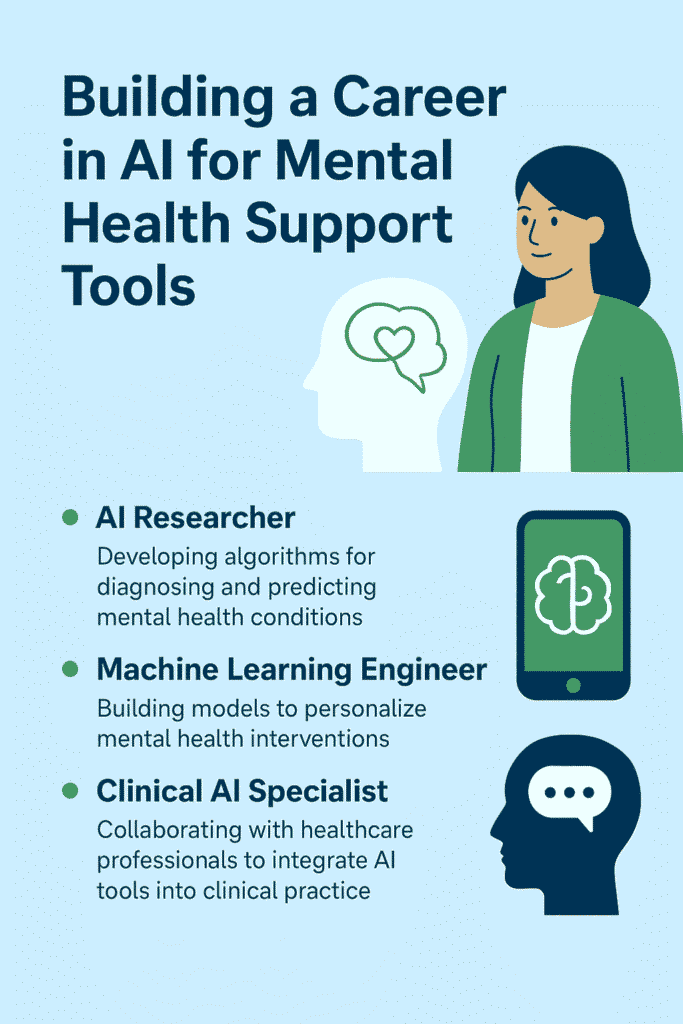Introduction
In recent years, Artificial Intelligence (AI) has begun transforming multiple sectors—including health and wellness. Among those, mental health support tools are one of the most promising and sensitive areas. From chatbots that offer cognitive behavioural therapy (CBT) techniques, to predictive tools that detect signs of depression, to AI‑powered apps helping with anxiety, AI is enabling greater access, personalization, and scale in mental health care.
If you are interested in combining technology with humanity and helping people, building a career in AI for mental health support tools can be deeply rewarding. This field sits at the intersection of computer science, psychology/psychiatry, data science, UX / design, ethics, regulation and business.
This article explores how to build a career in this field: what skills you need, what paths are possible, what challenges you’ll face, and how to thrive. We’ll also sprinkle in SEO‑friendly advice so that your own profile, website, or content (if you go into consulting or product building) gets visible to the right people.
Table of Contents
Why AI in Mental Health is Important & Timely
Before diving into how, let’s see why AI in mental health is such a powerful and timely area.
- Rising Mental Health Needs Globally
Mental health issues—anxiety, depression, stress, burnout—are increasing globally, especially post‑COVID, in urbanized settings, among youth, etc. There’s a large gap between need and access. - Access & Scalability
Many people don’t have access to mental health professionals, or cannot afford them, or face stigma. AI tools can help at scale, 24/7, in multiple languages, and in remote areas. - Personalization & Early Detection
AI models can analyze large amounts of data (behavioural, linguistic, wearable sensors, etc.) to spot early warning signs, tailor interventions, provide feedback, and adapt to individual’s patterns. - Cost Efficiency
Once built, AI solutions can often deliver support at lower cost per user compared to purely human‑delivered therapy, thereby potentially reducing barriers to care. - Innovation in Tech & Data
Advances in large language models (LLMs), natural language processing (NLP), speech & voice analysis, computer vision, wearable sensors, and multimodal AI make new types of tools possible. This opens many new career and research directions. - Ethical & Legal Focus
Because mental health is sensitive, there is rising focus on responsible AI (privacy, bias, safety, validation), thus professionals who understand ethics and regulation will be in demand.

What Kinds of Roles / Career Paths Exist
AI for mental health tools is multidisciplinary. Depending on your background, there are different paths. Here are some of them:
| Role/Path | Combination of Skills Involved | What You Might Do Daily / Project Types |
|---|---|---|
| Data Scientist / Machine Learning Engineer | ML, deep learning, NLP, signal processing, statistics | Build models to classify mental health status, predict risk (e.g. suicide risk), detect emotional states from text/voice, build chatbots, evaluate model performance. |
| Clinical Psychologist / Psychiatrist with AI Focus | Clinical training, mental health diagnostics, psychology + familiarity with tech/data | Provide domain expertise, annotate and validate data, help design interventions, ensure clinical safety, help evaluate tools for efficacy. |
| UX / Product Design / Human‑Computer Interaction (HCI) | UX design, usability, psychology of human emotions, interface design, ethics | Design user interfaces that are non‑stigmatizing, empathic, accessible; design conversation flows for chatbots; work on voice UX or VR/AR experiences. |
| AI Researcher / Academic | Research skills, writing papers, understanding of architectures, datasets, ethics, evaluation metrics | Publish new methods (e.g. new dialogue systems, new safety methods), explore frontier areas such as domain‑specific constitutional AI for mental health chatbots. arXiv+2arXiv+2 |
| Product Manager / Strategy / Innovation | Product management, understanding of user and market needs, regulation, clinical contexts, business models | Define features, roadmap, work with engineering / clinical team, ensure compliance, bring product to market. |
| Policy / Ethics / Regulatory Specialist | Law, ethics, health policy, privacy, data protection (like GDPR etc.), bias mitigation | Help set guidelines, ensure tool compliance with regulation, assess risk, data privacy, fairness. |
| Quality Assurance / Testing / Clinical Trials | Testing, evaluation methodology, clinical trial design, UX testing, validation | Test the tool, ensure safety, measure outcomes, A/B testing, user studies. |
| Implementation / Deployment / Maintenance | DevOps, software engineering, security, monitoring, scalability | Deploy tools, maintain systems, monitor performance and errors, ensure data security, respond to feedback. |
Key Skills & Knowledge Areas to Develop
To succeed in these roles, you’ll likely need to acquire or strengthen the following:
- Technical / Data Skills
- Machine Learning & Deep Learning: supervised / unsupervised learning, classification, regression, sequence models; familiarity with frameworks like TensorFlow, PyTorch.
- Natural Language Processing (NLP): text preprocessing, embeddings, sentiment analysis, transformer models, dialogue systems, LLM fine‑tuning.
- Multimodal Data: voice / audio, video, wearable sensors data if you are dealing with non‑textual signals.
- Software Engineering: writing production‑quality code, APIs, backend/frontend, version control, testing.
- Data Management: data collection, cleaning, preprocessing; understanding bias; dealing with missing data; ensuring data quality.
- Domain Knowledge in Mental Health
- Basic understanding of psychiatric / psychological disorders: depression, anxiety, trauma, PTSD, etc.
- Understanding therapeutic techniques (CBT, DBT, mindfulness, etc.).
- Knowledge of human‑centred design: empathy, usability for vulnerable populations.
- Understanding of ethics, privacy, and legal requirements in health data (HIPAA in US, GDPR in Europe, etc.).
- Regulation, Ethics, Safety
- Responsible AI practices: bias detection & mitigation, fairness, transparency, interpretability.
- Safety in mental health tools: crisis detection, suicidal ideation, handling sensitive content.
- Data privacy and security: encryption, data anonymization, consent, secure storage.
- Clinical validation: trials, user studies to validate effectiveness and safety of your tool.
- Soft Skills
- Communication: ability to explain technical ideas to non‑technical people (clinicians, stakeholders, users).
- Empathy & ethics: to understand users’ vulnerabilities and design carefully.
- Collaboration: working across disciplines (tech, psychology, design).
- Research mindset: staying up to date with literature, evaluating evidence.
- Product / Business Skills
- Product design: user journeys, prototypes, usability testing.
- Project management: deadlines, stakeholder management, scope.
- Marketing / User acquisition: understanding how to reach target user populations, especially for health‑tech tools.
- Funding / Grants / Business Models: health systems, insurers, private pay, subscriptions, B2B / B2C models.
Educational Paths & Certificates
If you are starting out or want to build credibility, consider these educational paths / credentials:
- Degrees: Computer Science, Data Science, Psychology, Psychiatry, Biomedical Engineering, Cognitive Science.
- Specialized master’s degrees or dual degrees combining health / psychology + AI / data science.
- Online courses / MOOCs:
- Bootcamps for data science or NLP.
- Internships / research assistantships in labs doing related work; real‑world projects.
- Conferences, workshops in mental health tech, AI safety, etc.
Building a Portfolio / Practical Experience
Academic credentials are important, but practical experience often decides how far you go. Here’s how to build a solid portfolio:
- Projects
- Build small tools or proofs of concept: chatbot for mood tracking, sentiment classifier for journal text, voice‑based stress detector.
- Use open datasets (anonymized) for mental health (if available) to train and test models.
- Collaborations
- Work with mental health professionals (psychologists, psychiatrists) to get domain feedback.
- Participate in interdisciplinary teams (design, engineering, clinical).
- Open Source / Research
- Contribute to opensource projects related to mental health tech.
- Publish papers or blog posts on lessons learned, experiments, evaluation.
- Internships / Resident Programs
- Get internships in companies building mental health or wellness apps.
- Research labs working on mental health, AI or NLP.
- User Testing & Feedback
- Always include end users and vulnerable populations in testing.
- Iterate based on feedback; monitor real‑world usage.
- Ethical / Safety Audits
- Create or participate in audits: checking bias, privacy, safety.
Tools, Frameworks, & Platforms You Should Know
Knowing certain tools and frameworks will help you ramp up faster:
- Machine Learning Frameworks: TensorFlow, PyTorch, Keras.
- NLP / LLM Tools: Hugging Face transformers, OpenAI API, LLaMA, etc.
- Dialogue Systems: RASA, BotPress, Dialogflow, Microsoft Bot Framework.
- Speech and Audio: Librosa, SpeechRecognition, wav2vec, etc.
- Multimodal Tools: Computer Vision frameworks, sensor data tools.
- Cloud Platforms: AWS/GCP/Azure – for scalable infrastructure, hosting, deploying models.
- Privacy / Security Tools: Differential privacy libraries, secure data storage, encryption.
- UX / Design Tools: Figma, Adobe XD, user research tools.
Ethical, Legal, and Safety Considerations
Because mental health involves people’s vulnerabilities, mistakes can have serious harm. Here are critical considerations.
- Privacy & Confidentiality
- Personal, medical, and mental health data must be handled securely.
- Obtain informed consent; data anonymization; secure storage.
- Understand local legal frameworks: GDPR, HIPAA, etc.
- Bias & Fairness
- Models should be trained on diverse datasets to avoid bias along gender, race, language, socio‑economic status.
- Test for unintended harm: false positives/negatives, cultural insensitivity.
- Safety in Vulnerable Situations
- Must have mechanisms to detect self‑harm or suicidal ideation and route to human help or emergency services.
- Avoid content that could exacerbate problems.
- Transparency & Explainability
- Users should know when they are interacting with AI vs human.
- Be transparent about limitations of the tool; disclaimers.
- Models/logics should be interpretable enough for audit.
- Clinical Validation
- Evaluate tools with user studies or clinical trials.
- Measure usability, efficacy, adverse effects.
- Regulatory Compliance
- In many countries, mental health tools may be regulated (medical device regulation, telemedicine laws).
- Ensure compliance, possibly seek certification.
- Ethical AI Practices
- Use domain‑specific constitutional AI or similar safety methods for chatbots in mental health. (See recent research on using domain‑specific constitutional AI to enhance safety in LLM‑powered mental health chatbots.) arXiv
- Adopt best practices in AI governance.
Challenges & Risks
Every emerging field has its risks. Knowing them helps you plan and manage.
- Lack of Human Empathy: AI cannot fully replicate the human connection important in therapy.
- Misdiagnosis / Overdependence: AI tools may give incorrect suggestions; users might depend on AI instead of seeking professional help.
- Data Scarcity & Quality: Good labelled data especially with clinical labels and in sensitive contexts is hard to procure.
- Bias & Cultural Differences: Models trained in one region or culture may not generalize well elsewhere.
- Regulatory Uncertainty: Laws may lag behind tech; liability in case of harm is often unclear.
- User Trust & Acceptability: People may be wary of using AI for mental health; privacy concerns, stigma.
- Business & Funding Challenges: Monetization, cost of compliance, cost of validation, scaling infrastructure all need investment.
- Sustainability: Keeping systems operational, updating models, managing maintenance overhead.
How to Position Yourself Strategically
To build a sustainable, fulfilling career in this area, it helps to be strategic in how you position yourself.
- Specialize in a Niche
- You might specialize in certain disorders (e.g. anxiety, PTSD), or age groups (children, adolescents, elderly), or modality (voice‑based, text, VR/AR), or context (corporate wellness, schools, low‑resource settings).
- Build Credibility / Authority
- Publish papers, attend conferences.
- Present at workshops.
- Get certifications.
- Networking
- Connect with both tech AI people and mental health professionals.
- Join relevant online communities, meetups.
- Collaborate with institutions (universities, hospitals, NGOs).
- Stay Updated
- AI is fast evolving: newer LLMs; better safety techniques; regulatory changes.
- Read research, follow standard bodies, attend webinars.
- Focus on Ethics and Safety
- As trust and safety are big concerns for mental health tools, having recognized expertise or experience in ethical AI, clinical safety, or regulatory compliance can set you apart.
- Learn to Communicate Well
- Being able to explain complex technical or clinical concepts in clear, empathetic, non‑technical language is valuable, especially when working with stakeholders or users.
- Mix Technical + Domain Expertise
- The strongest professionals often combine both: e.g. someone with background in psychology who also has data science skills, or an engineer who deeply understands mental health issues.
Steps to Start & Grow Your Career: A Roadmap
Here’s a suggested roadmap you can adapt depending on where you are (student, early professional, switching careers):
| Stage | What to do | Milestones to Aim For |
|---|---|---|
| Stage 1 – Early / Exploration | • Learn basics of AI / ML / NLP / statistics. • Take online courses in psychology / mental health basics. • Build simple projects (chatbot, sentiment analysis etc.). • Read academic papers & case studies in AI for mental health. | Have 2‑3 small projects in your portfolio. Be comfortable with basic ML/NLP workflows. Have enough domain knowledge to talk with clinicians. |
| Stage 2 – Specialization & Collaboration | • Pick a niche (type of disorder, demographic, modality etc.). • Intern or volunteer with mental health organizations or startups. • Work on real datasets; possibly do user research. • Start learning about ethics, regulatory frameworks. • Build or contribute to tools that address real user / clinical needs. | Publish or present at least once, or write substantive blog posts or detailed case studies. Get feedback from domain experts. Possibly contribute to an open source tool. |
| Stage 3 – Professional Work / Product Building | • Join or found a startup, company, or project in the space. • Engage in deploying, monitoring, maintaining tools. • Participate in outcome measuring / clinical validations. • Keep raising your profile — public speaking, writing, networking. • Handle regulatory, legal, privacy compliance, safety protocols. | A product or service released; measurable outcomes (user satisfaction, efficacy, safety). Recognized as credible in your specialization. Possibly leadership roles. |
| Stage 4 – Leadership & Impact | • Lead teams or research groups. • Influence policy or standardization in AI mental health tools. • Work to scale tools to larger populations or underserved regions. • Mentor others entering the field. • Contribute to foundational work (new methods, safety, ethics, etc.). | Recognized expert; tools / platforms used by many; involvement in policy or standards; perhaps academic publications; influencing how care is delivered. |
Example Use Cases & Existing Projects
Having concrete examples helps you see what is possible, and which spaces are active.
- Serena: A deep learning dialogue system fine‑tuned for person‑centered therapy sessions. It uses a transformer‑based model and post‑processing to improve coherence and safety. arXiv
- Psy‑LLM: A framework leveraging large language models as front‑end assistive tools in psychological consultation settings: to generate responses, provide mindfulness or stress relief tools, and screen urgent cases. arXiv
- Domain‑Specific Constitutional AI: Recent work focusing on enhancing safety in LLM‑powered mental health chatbots by applying mental health‑domain principles in training and guardrails. arXiv
- Commercial / Startup Tools: Chatbots / apps like Wysa, Lyra Health, Spring Health etc., which use conversational AI, outcome tracking, wellbeing coaching etc. (These are referenced in discussions of corporate wellness apps etc.) Biz4Group
These illustrate both strengths (scalability, user engagement) and weaknesses (hallucinations, safety, coherence, clinical validation).
Search Engine Optimization (SEO): Making Your Work & Profile Discoverable
If you build a product, write blog posts, or need to promote yourself (e.g. consulting, freelancing), SEO becomes important. Here are SEO‑friendly strategies tailored to AI & mental health.
- Identify Keywords / Phrases
- Long‑tail keywords: “AI mental health tools,” “chatbot for anxiety,” “online therapy app safety,” “AI depression assessment,” “AI wellness companion,” etc.
- Use tools like Google’s People Also Ask, AnswerThePublic, SEMrush, Ahrefs, etc.
- Think about what potential users / stakeholders search for: mental health professionals, users, caregivers.
- Produce High‑Quality, Trustworthy Content (E‑E‑A‑T)
- E‑E‑A‑T = Experience, Expertise, Authoritativeness, Trustworthiness.
- If you are writing about mental health + AI, show your credentials or collaboration with domain experts.
- Use references to reliable studies, peer‑reviewed sources.
- Answer Frequently Asked Questions
- “Is AI therapy safe?”, “Can chatbots treat depression?”, “How does AI detect suicidal ideation?”, “What are ethical risks of AI in mental health?” etc.
- Use FAQ pages, blog posts, Q&A content.
- Localize If Relevant
- If you are targeting specific geographies (e.g. “AI mental health tools in India”, “online counseling platform for Telugu speakers” etc.), include local keywords, local culture, language.
- Optimize Technical SEO
- Mobile friendliness, fast load times.
- Secure site (HTTPS), clean UI.
- Good site structure, headings, metadata, schema markup (especially health‑related content).
- Use alt text in images, descriptive titles and descriptions.
- Backlinks & Partnerships
- Write guest posts for mental health / tech publications.
- Participate in podcasts, webinars.
- Collaborate with universities, NGOs, health organizations to get authoritative mentions or links.
- Content Formats
- Blog posts, case studies, whitepapers.
- Infographics, videos, podcasts especially around mental health experiences.
- Tools / calculators, especially for self‑assessment, mood trackers etc.
- Regular Updates
- AI and mental health is a fast‑moving field. Update older content when new research or regulations appear.
- Post about trending topics: e.g. mental health in AI safety, AI psychosis, domain‑specific safety, recent laws etc.
What Employers / Organizations Are Looking For
Understanding what companies, non‑profits, academic labs, and health institutions value helps you align your development.
- Candidates who can bridge tech + domain: e.g. engineers who understand psychology, or psychologists who are comfortable with ML or data.
- Portfolios showing real projects, especially those with user feedback, safety/ethics work, or measuring outcomes.
- Awareness and experience with regulatory compliance and data privacy.
- Experience working in or with cross‑functional teams: product, UX, clinical, legal.
- Strong communication and ability to translate between technical and clinical perspectives.
- Problem solving, especially for deployment issues: scaling, robustness, dealing with noisy data etc.
- For senior roles: leadership, ability to define strategy, ensure product safety and ethical standards.
How to Break Into the Field (Especially if You’re Starting Fresh)
If you’re new to either AI or mental health, here are actionable tips to start:
- Start with Education
- Pick foundational online‑courses: basic ML, NLP, data ethics, mental health / psychology intro.
- Free resources (MOOCs) are abundant.
- Build Mini‑Projects
- Sentiment analysis tool on journaling data.
- Chatbot prototype for encouragement or mood check‑ins (with disclaimers).
- Stress detection from voice or text.
- Volunteer or Intern
- Volunteer with mental health NGOs, helplines to understand user needs.
- Intern at startups working in wellness / mental health.
- Find Mentors / Collaborators
- Clinicians / mental health professionals willing to advise.
- AI researchers or engineers interested in applied / ethical technology.
- Document & Publish
- Write blog posts about your learning, project results.
- Share code on GitHub or open source.
- Participate in Research / Competitions
- Hackathons, ML competitions (Kaggle etc) focused on health or mental health.
- Collaborate on research projects.
- Focus on Ethical Awareness Early
- Even in early projects, think of safety, privacy, user risk.
- Understand Regulatory or Local Health Systems
- Laws in your country about telehealth, data privacy, mental health practice.
Trends & Future Directions (What to Watch)
Knowing where the field is headed can help you anticipate where to focus.
- More advanced safety frameworks: e.g. constitutional AI, domain‑specific guardrails. arXiv
- Multimodal mental health tools: combining text, voice, video, physiological data (e.g. heart rate, skin conductance).
- Real‑time / near‑real‑time support: especially mobile, wearables.
- Personalization & adaptive interventions: tools that adapt to a user’s progress, preferences.
- Integration with health systems / telemedicine: interoperability, compliance, integration with clinical workflows.
- Regulation catching up: medical device classification, privacy laws, guidelines for AI in health.
- Cultural & global reach: tools made for non‑English, low‑resource settings, mindful of cultural differences.
- Explainability & interpretability: users and clinicians will demand to understand how models make decisions.
- AI ethics and trustworthiness as core, not optional.
Example of Portfolio Project Ideas You Could Do
Here are some concrete project ideas to build into your portfolio. They can also serve as stepping stones for product ideas.
- Mood Tracking & Sentiment Tracker App
- Users write daily journals or voice logs. Use NLP to detect sentiment, changes over time. Provide visualizations.
- Use notifications to check‑in if negative mood persists.
- Conversational Agent / Chatbot for Coping Skills
- A chatbot that offers coping techniques (mindfulness, breathing exercises, grounding) when users say they’re stressed.
- Possibly built with RASA or DialogueFlow + fine‑tuned LLM.
- Stress / Anxiety Detector via Voice / Wearable Data
- Use voice features (e.g. pitch, tone) or biometric data (heart rate variability, sweat) to signal stress.
- Build simple model; test with volunteers; ensure privacy.
- Self‑help Resource Recommendation System
- Given user’s condition / symptoms, recommend articles, videos, exercises. Could use content categorization + ML.
- Crisis Detection Tool
- Detecting keywords (text) or user behaviour that suggests crisis (self harm, suicidal ideation). Provide resource suggestions or route to human help.
- Localization / Cultural Adaptation
- Adapt tools to local languages, cultural contexts. Test whether the tool’s content / suggestions make sense culturally. Could be for India, Africa, Latin America etc.
- UX / Human Factors Study
- Study how users interact with mental health tools; evaluate what design features increase trust or engagement.
- Ethics & Fairness Audit
- Take an existing tool (or build a small one) and perform audit for bias (by gender, race, socioeconomic status etc.), privacy, safety.
Challenges Specific to India / Low‑Resource Settings
If you are in India (or similarly situated countries), there are special opportunities & challenges. Understanding these can shape your career direction.
Opportunities:
- Large population with rising awareness of mental health needs; many places underserved.
- Growing digital / mobile penetration; smartphone‑based tools have wide reach.
- More flexibility to innovate with low‑cost solutions.
- Potential for localization (languages, culture) and vernacular tools.
Challenges:
- Data availability: public, high‑quality clinical datasets may be limited; obtaining them with privacy / consent is harder.
- Regulatory uncertainties: Health / mental health regulations may be less clearly defined for AI tools; navigating legal / compliance may be tough.
- Digital literacy, connectivity, language barriers. Users may prefer voice or local languages.
- Cultural stigma: mental health is often stigmatized; trust issues.
- Funding and resources: getting investment, grants for health tech may be harder; cost of clinical validation expensive.
If you are in India, consider collaborating with universities, NGOs, government health schemes; focus on vernacular tools; low cost, mobile first; privacy; offline support or low bandwidth.
How to Get Funding / Monetization Strategies
If you are launching a startup / product, or want to build tools that scale, understanding funding and monetization is key.
- Grants / Research Funding: Public health agencies, NGOs, government funds for digital health.
- Institution / Hospital Partnerships: Partner with mental health clinics, hospitals, mental health services to pilot tools.
- Enterprise / Corporate Wellness: Many companies focus on employee wellness; tools can be sold B2B to employers.
- Subscription Models: Users pay small fees. Must balance access vs affordability.
- Freemium + Paid Tiers: Offer basic tool free; advanced features paid.
- Insurance / Reimbursement: If regulators accept tools as digital health / medical devices, then possible reimbursement.
- Donations / Non‑profit Models: For tools aimed at underserved populations.
- Ads / Affiliate / Content Monetization: Less ideal in mental health field due to ethical concerns; be careful.
Measuring Success & Impact
What metrics matter in this domain?
- User engagement: usage frequency, retention.
- User satisfaction / reported improvements: surveys, feedback, self‑reported mental health improvements.
- Clinical outcomes: reduction in symptom scores, validated measures (e.g. PHQ‑9, GAD‑7 etc.).
- Safety incidents: number of adverse events, escalations.
- Accuracy of models: precision, recall, false positives/negatives, calibration.
- Fairness / bias metrics: performance across demographics.
- Regulatory & legal compliance: audits passed, certifications.
- Scalability / cost per user: operational costs, infrastructure, support.
Real Life Example of a Career Path (Hypothetical)
Here is a hypothetical person’s journey to illustrate how one might build such a career:
- Phase 1 (Student):
Study Computer Science + take elective courses in psychology. Build a few projects: sentiment analysis, chatbot prototype. Participate in hackathons. - Phase 2 (Early Professional Role / Internship):
Intern with a startup working on mental health app; assist data pipelines, annotate datasets, work with clinical psychologists to understand user needs. - Phase 3 (Specialization):
Pick a niche: say, building tools for adolescent anxiety. Take specialized courses, work on a volunteer project or thesis. Start a product MVP. - Phase 4 (Full‑time Role / Product Launch):
Join or found a startup, manage end‑to‑end including safety, UX, data, deployment. Collaborate with clinicians, ensure clinical trials or validation. Market tool / app. - Phase 5 (Leadership & Influence):
Grow team; perhaps influence policy; publish work; expand product use globally; mentor others; possibly serve on advisory boards / regulatory committees.
Summary
Building a career in AI for mental health support tools is challenging but highly meaningful. You’ll need a blend of technical skills, psychological / clinical domain knowledge, ethics, user empathy, product sense, and regulatory awareness. Starting with education, projects, collaborating with experts, and staying updated are keys. The field is expanding rapidly; those who can bridge the gap between technology and human care, and who prioritize safety, fairness, and user trust, will be in demand.
follow us on whatsapp channel

















